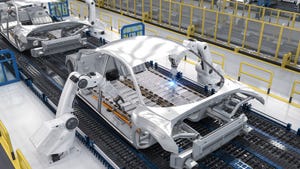Worcester Polytechnic Institute research Yan Wang has found that recycled cathode materials outperform those made from virgin material.
November 15, 2021

At the COP26 climate summit, Daimler, Ford, and General Motors, along with China’s BYD, committed to building only electric vehicles by 2035. Technology advances have made this a realistic prospect, but the ability to get the raw materials needed for so many EVs remains in doubt.
The supply crunch can be eased by recycling dead batteries and reusing those materials as part of a circular economy, as is planned by battery recycling startup Redwood Materials. But are recycled materials just as good as virgin raw materials when making new batteries?
That was the question for Professor Yan Wang, of Worcester Polytechnic Institute, in his paper “Recycled cathode materials enabled superior performance for lithium-ion batteries.” The title reveals his findings that in fact, recycled materials are even better than virgin when making battery cathodes.
“As demand grows for lithium-ion batteries, it will be important to recycle materials from used batteries, especially batteries from electric vehicles,” Wang said. “Battery manufacturers want to know that recycled cathode materials are not inferior to new cathode materials. This research shows that recycled materials can electrochemically match or outperform pristine, state-of-the-art cathode materials from tier 1 suppliers.”
Wang collaborated on the paper with researchers from A123 Systems, Battery Resourcers, Argonne National Laboratory, Rice University, Brookhaven National Laboratory, and the United States Advanced Battery Consortium (USABC).
We put in a call to chat with Professor Wang to learn a bit about his findings.
Why is recycling the materials in batteries so important?
Yan Wang: First of all, recycling can prevent environmental pollution from spent batteries due to its toxic composition. Secondly, because of the moral issues and difficulty of mining, the raw materials have a long process and expensive price. And at last, raw materials are limited resources. With the fast development on EVs, the demand will be more than the supply soon. Thus, to protect the environment, reduce the cost of lithium-ion batteries and release the pressure on the supply chain, recycling the materials in batteries is very important.
What are the potential cost benefits of using recycled material?
Yan Wang: Based on some predictions, the cost saving could reach 43 percent of the cost of the cathode materials made from materials, leading to the decreased cost of lithium-ion batteries.
What were the difficulties of recovering the material for recycling and how did you overcome those obstacles?
Yan Wang: The main difficulties are sorting and regenerating cathode materials. As we all know, there are lots of types of lithium-ion batteries in the market. And because of the confidentiality, the manufacturer won’t label them, which could introduce impurities due to the different materials in the spent batteries.
Our team used a shredding process to avoid the sorting step. And then, we removed impurities by adjusting the pH numbers. Another difficulty is because that the recycled solution is more complex than the solution of virgin materials.
After a series of treatments, the recycled solution includes more ions than that of the virgin solution. Thus, it is a big challenge that how to use recycled solutions to produce good cathode materials. We did lots of experiments to find the optimized parameter for the recycled solution.
How suitable is the process you’ve developed for high-volume industrial use?
How suitable is the process you’ve developed for high-volume industrial use?
Yan Wang: Since we developed the recycling process, scalability is in our mind. In fact, Battery Resourcers, a spin off from Worcester Polytechnic Institute, is commercializing the recycling process.
How does the performance of batteries made using the recycled cathode material compare to batteries made with virgin material?
Yan Wang: Our recycled lithium nickel manganese cobalt oxide (NMC111) has the best cycle life result reported for recycled materials and enable 4,200 cycles and 11,600 cycles at 80 percent and 70 percent capacity retention, which is 33 percent and 53 percent better than the state-of-the-art, commercial NMC111. Meanwhile, its rate performance is 88.6 percent better than commercial powders at 5C.
What caused the difference, and what is the opportunity for optimizing this mechanism for ever greater gains?
Yan Wang: The recycled materials have an optimized microstructure of larger surface area, cumulative pore volume and larger inside void which provide higher Li chemical diffusion coefficient and mitigate the strain during cycling and this leads to less phase transformation and benefits superior performance. This optimizing should be benefited from the complex recycled solution, which has more other ions.
About the Author(s)
You May Also Like



